This set of Molecular Endocrinology Multiple Choice Questions & Answers (MCQs) focuses on “Mineral Metabolism – Endocrine Glands”.
1. Which endocrine gland is shown in the diagram given below, that plays a major role in regulating essential body functions and general well-being?
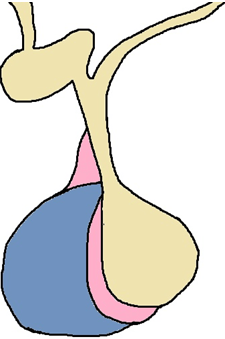
a) Pituitary gland
b) Pineal gland
c) Hypothalamus
d) Adrenal gland
View Answer
Explanation: The pituitary gland is a tiny pea-sized gland that plays an important role in controlling vital functions of the body and general well-being. It is referred to as the ‘master gland’ of the body because it regulates the function of most other glands that secrete hormones.
2. Which endocrine thyroid hormone regulating gland is present in the diagram given below?
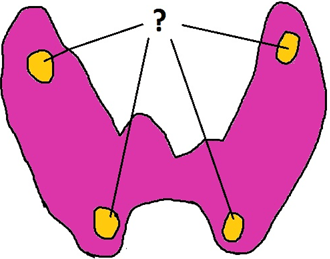
a) Epithelian gland
b) Parathyroid gland
c) Pineal gland
d) Nexin gland
View Answer
Explanation: Parathyroid glands are four tiny endocrine system glands that regulate the calcium in our bodies. Parathyroid glands are located behind the thyroid in the neck, where blood calcium levels are constantly tracked and regulated.
3. In the diagram given blow which shows parathyroid hormone–cyclin D1 DNA rearrangement in a subset of parathyroid adenomas, which gene regulating region is present in the beginning?

a) PTH gene
b) Calcitonin gene
c) Cyclin gene
d) DAS region
View Answer
Explanation: The region here represents the PTH Gene 5′ regulatory region with noncoding exon I. The dark X indicates the chromosome breakpoint between the regulatory region of the parathyroid hormone gene (PTH) plus the noncoding exon of PTH.
4. In the given structure of pancreas, the marked structure represents the islet of Langerhans.
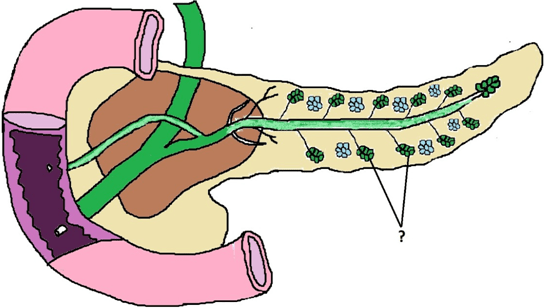
a) True
b) False
View Answer
Explanation: The leaf like structure in the pancreas represents the acinar cells. The endocrine pancreas is organized into islets of Langerhans, consisting of five subtypes of cells: glucagon, insulin, somatostatin, ghrelin, and pancreatic polypeptide secreting cells, β, δ, ε, and PP, respectively. Just 2 percent of the adult pancreatic mass consists of islet cells.
5. The figure given here represents the molecular formula of vasopressin.
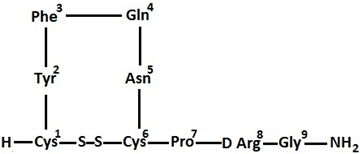
a) True
b) False
View Answer
Explanation: The figure here represents the man-made form of vasopressin which is desmopressin. Desmopressin differs from arginine vasopressin in that it deaminates the terminal cystine and arginine is a D rather than a L isomer at position 8. Desmopressin has 10 times more vasopressin’s antidiuretic action, but 1500 times less vasoconstrictive action.
6. The diagram given blow represents which blocking agent of thyroxine (T3)?
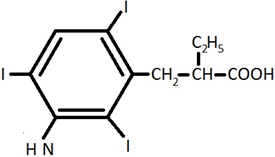
a) Amiodarone
b) Iopanoic acid
c) Dexofin
d) Lecithin
View Answer
Explanation: Iopanoic acid is represented in the diagram given here. Competitive inhibitors of all three iodothyronine deiodinases, T3, triiodothyronine, are iopanoic acid and related iodoanilines. Iopanoic acid is a radio-contrast medium containing iodine that is used in cholecystography.
7. In the diagram given below which show the potential pathway for entry of triiodothyronine (T3) into the central nervous system, in which site does the thyroxine (T4) is converted to T3?
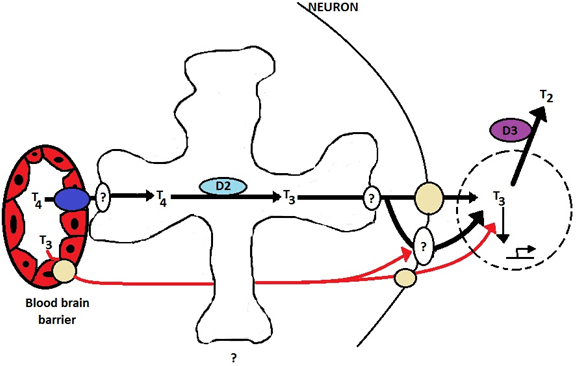
a) Astrocyte
b) Lymphocyte
c) Calinkin
d) Barocyte
View Answer
Explanation: Thyroid hormones are synthesized in the follicular lumen in the thyroglobulin molecules. Organic anion transporting polypeptide helps in the transport of thyroid hormones through the blood brain barrier. As seen in the figure given above, Thyroxine is transformed to T3 in the astrocytes which is then taken to the neurons.
8. The diagram given below represents the molecular formula of which posterior pituitary hormone?
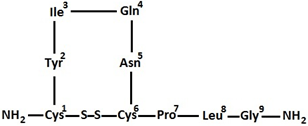
a) Vasopressin
b) Desmopressin
c) FSH
d) Oxytocin
View Answer
Explanation: Oxytocin is a nine-amino-acid peptide. Cysteine-tyrosine-isoleucine-glutamine-asparagine-cysteine-proline-leucine-glycine-is the series of amino acids. A sulphur bridge forms the cysteine residues. The molecular mass of oxytocin is 1007 Daltons.
9. Which water homeostasis regulating pituitary hormone is represented in the figure given below?
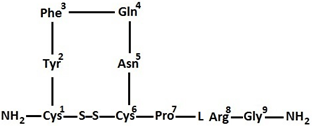
a) Vasopressin
b) Oxytocin
c) FSH
d) LH
View Answer
Explanation: Desmopressin is the artificial from of arginine vasopressin synthesized commercially. This is shown in the diagram given above. In patients with diabetes insipidus, this medicine serves to prevent the uncontrolled urination by increasing the reabsorption of water in the kidney. It also helps in reducing thirst feeling in such patients.
10. The figure given below represents the synthetic analogue of which pituitary hormone?
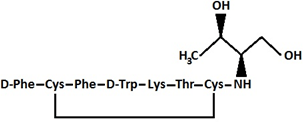
a) Vasopressin
b) Somatostatin
c) Oxytocin
d) FSH
View Answer
Explanation: Here, the agonist of somatostatin, Octreotide, is represented. It has all the physiological and endocrinal functions of the inhibitory hormone, somatostatin. This drug has inhibitory effect in GI, pancreas, hypothalamus etc. Chemically, octreotide is an octapeptide with a single disulfide bridge.
Sanfoundry Global Education & Learning Series – Molecular Endocrinology.
To practice all areas of Molecular Endocrinology, here is complete set of 1000+ Multiple Choice Questions and Answers.
If you find a mistake in question / option / answer, kindly take a screenshot and email to [email protected]
